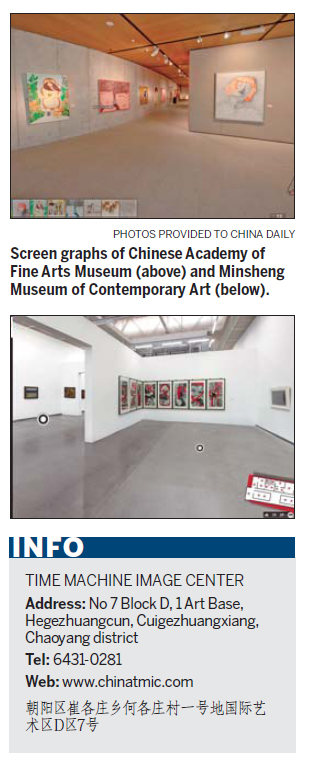
Anyone who has used Google Maps with Street View, which uses 360-degree street-level imagery, has been on a virtual tour.
 Now, China is using these same multimedia techniques to enhance exhibitions and make virtual tours that will make museums accessible to people unable to visit the actual building.
Now, China is using these same multimedia techniques to enhance exhibitions and make virtual tours that will make museums accessible to people unable to visit the actual building.
"Virtual tours make history accessible 24 hours a day, seven days a week," said Nils Duval.
Duval, 27, is part of a small team working on a virtual tour project for the China Central Academy of Fine Arts. They have already produced tours for the Minsheng Museum of Contemporary Art in Shanghai.
Duval, who hails from Normandy, France, studied photography and multimedia technology at the Paris 8 University and now works as the technical manager for Time Machine Image Center, said the biggest challenge for China's museums is recovering the past and making it accessible to people in the present.
"All galleries, museums and exhibitions can benefit from virtual documentation. Books on exhibitions expound on the live events, but with multimedia you can go further with how you document history."
The virtual tours, or 360-degree panoramas, are basically a number of still images of a room or location that are "stitched" together to create a 360-degree image that can be viewed as dynamic interactive animations. They allow viewers to journey through an exhibition and click if they want more information about an artifact.
"Our work doesn't replace the exhibition, it enhances it. Virtual tours allow viewers to understand the story behind the exhibition from A to Z."
One of the problems with rotating exhibitions is that the historical research and work that went into the creation of the exhibit is lost once the exhibit itself is taken down.
"A virtual tour creates a model of the exhibition so that the audience can view it again and again. The information is always there," said Duval.
You can see more of Time Machine Image Center's virtual tours at the upcoming Beijing Contemporary Art Fair.
HOW TO STITCH IT ALL TOGETHER
Photographer Nils Duval’s step-by-step guide to taking panoramic and 360-degree shots:
• Early morning is the best time for high quality shots. Pick a location where you are free to move around without being disturbed and your field is clear of obstructions.
• Always use a tripod. However, pivot the lens rather than the tripod for better mathematical shots.
• When taking shots for a 360 project, the more images you take, the better. Simply turning in the four primary directions is not enough.
• If the sun is not in an optimal position, use the flash, but only if your subject matter is in the foreground.
• Once you have the shots you need, stitch them together with Hugin, an open-source program, or Adobe Photoshop, which has a “photo merge” tool.
Most importantly, have fun and always keep trying new things.
(China Daily 04/19/2011 page36)